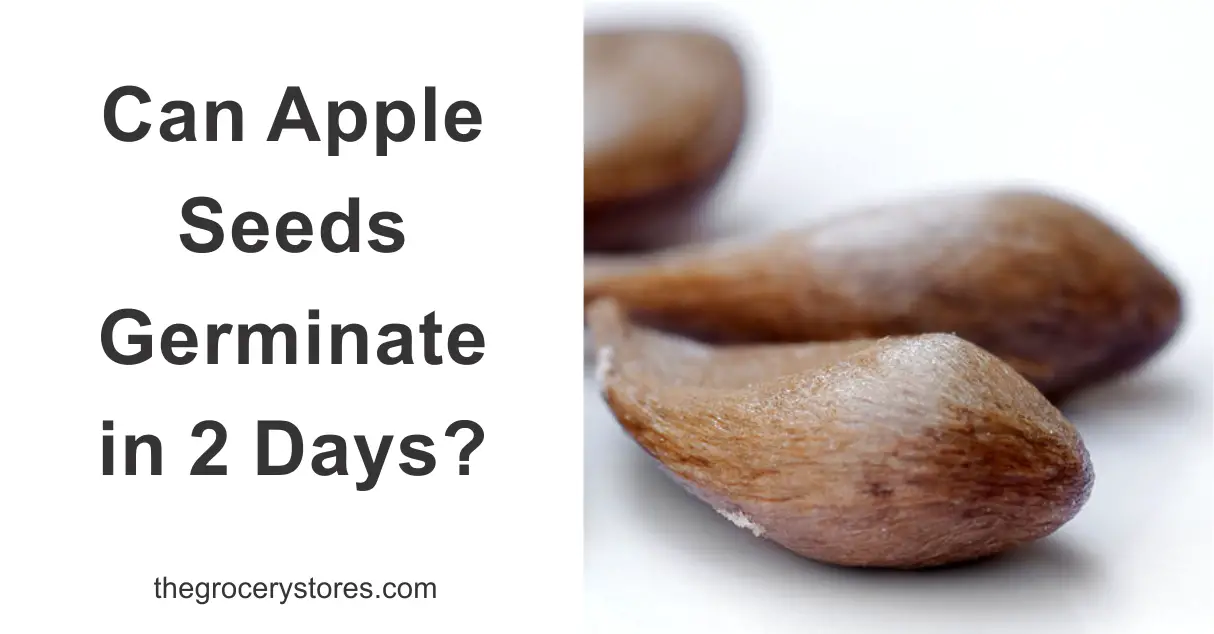Apples are always a nice treat. And after having one, you might just be thinking if you could grow one, so you can have your own supply of apples.
The truth is, though you can germinate an apple in your backyard, it won’t germinate in two days. Apple seeds generally take between 60 and 90 days to germinate. And even at that, their trees take about 6 to 10 years to begin bearing fruit.
How do you germinate apple seeds faster?
You have just eaten some wonderful apples, and then suddenly, a thought comes to your mind. “How can I grow mine so I can have a supply of them right from my backyard?” This forms part of every vegetarian or fruit lover’s dream: to have an endless supply of fruits and vegetables without having to go to the grocery store every time you run out of them.
Apples are a wonderful fruit full of vital nutrients that everyone must have in their diets. It is so good that there is a saying, “An apple a day keeps the doctor away.” The good news is that you can grow this wonderful fruit in some quick and easy steps. So let’s dive right in.
Before you start growing apples, there are a few things you need to be aware of.
- Apple seeds need to be mature: Whatever seeds you are going to use, they need to be mature. The seeds you will select for this project will have a dark brown coating. This is an indication that they are fully formed. Some apples you will eat might have white casings in place of seeds.
- Apples undergo cold stratification: For the uninitiated, this simply means subjecting the seed to similar natural, cold, and damp conditions that it requires to germinate. Apple seeds require temperatures of between 3 °C and 5 °C before they can break dormancy and begin to grow. And you can easily simulate these conditions by wrapping them in a damp paper towel and placing them in a refrigerator for 6–8 weeks.
- Another thing to note is that most of the time, apples might not take after their parents. This means that that wonderful apple you just consumed might not produce apples that taste just as good. This is because most apples you see were cross-pollinated, and hence, they have a collection of different genes(from the pollinator tree and the pollinated tree). This is why plant breeders prefer to propagate vegetatively by grafting. This involves taking buds from genetically favored trees and then grafting them onto their own trees. This process could ensure high quality fruits.
- You must also know this. Some apple seeds won’t sprout, even if you meet all the necessary conditions for them to sprout. This is because some species of apples are that way. So, to increase the chance of your seeds germinating, choose a varied bunch of seeds. It is preferable that you even choose seeds from various species of apples.
Now that you have all this knowledge in mind, the next steps involve the actual preparations to make it germinate.
- Get the seeds ready: Look for mature, ripe apples and cut them open. Use a knife to carefully remove them from the core. Don’t damage them. As mentioned before, it is recommended that you get seeds from different types of apples. A number ranging between 10 and 20 seeds is okay.
- Scarify: The next step is to scarify the seeds. This is a process that involves using sandpaper to sand the outer coating of the seeds. This helps to soften the seed coat and make it easier to germinate. To do this, gently rub the sandpaper on the seed’s surface. Be careful so you don’t damage the embryo.
- Soak in a moist paper towel: After you have sanded the seeds, wrap them in a moist paper towel. Then you place them in a plastic bag or container. Ensure the paper towel is not too dry and not too wet.
Some people prefer to put in moist, damp soil. This will still work, but using paper towels gives you the opportunity to check your seeds without having to rinse off sand every time.
- Refrigerate: Now place the containers containing your apple seeds in your fridge. The optimal temperature for apple seed germination is between 3 and 5°C. Your refrigerator is usually in that range. Leave those seeds in the refrigerator for 6 to 8 weeks. Just ensure that you keep checking on them to ensure that they are constantly moist. Adjust the dampness levels as necessary.
- Plant them: Most of your apple seeds ought to have sprouted after 60 to 90 days. The length of time might vary. This all depends on the variety of seeds. However, that time range is optimum.
When the seeds have begun to sprout, the next step is to transfer these seedlings into a flower pot. There are options for planting it directly in your garden. However, it is better to plant it in your pot first as you can monitor it and see that the seedling is still in its formative stages.
To do this, get a 4-inch deep and wide pot. Put these sprouted seedlings into the pot. Place the pot in a cold place and water it lightly. When they reach a height of 2 inches and mature leaves begin to appear, you can transfer them into individual pots. This is to prevent their roots from tangling as they would have become longer. You can also trim the roots to encourage the growth of new feeder roots.
When night temperatures reach above 10°C, you can then decide to transplant them to their final position.
How long does it take for an apple seed to sprout in the fridge?
When apple seeds are put into a fridge, it should take between 60 and 90 days to sprout. This is enough time for the outer seed coat to undergo cold stratification and begin to bud. However, if after 90 days, your seeds still haven’t sprouted, you can remove them from the fridge and then place them somewhere in your house, where they will be kept at room temperature. Leave them for a few weeks. You could have a case of late sprouting on your hands.
How long do you soak apple seeds before planting?
The recommended length of time to soak apple seeds is 6 weeks. After that, you can decide to plant them in the soil right away. You soak the seeds to help their outer seed coats soften. This will then enable the embryo to break out and form the bud.
How many days does it take an apple to germinate?
Apple seeds take between 60 and 90 days to germinate.
Do apple seeds need light to germinate?
No, they don’t. Apple seeds just require darkness and the right combination of cold and moisture to germinate.
How often should I water apple seeds?
When apple seeds are still young, you should water them twice a week. However, when they have grown in size. You can reduce the frequency to just once every 10–12 days.
Can you plant apple seeds from an apple?
Yes, you can. All you just need to do is follow all the steps I have outlined previously in this article.
How long does it take to germinate seeds on a paper towel?
When the apple seeds are placed on a paper towel and placed in a fridge, it takes 6–8 weeks for them to germinate and sprout.
How can I make my apple tree grow faster?
Growing apple trees can be a fun and tedious process all rolled into one. This is because for you to get perfect apples that could be award-winning, you must really know what you are doing. Apple trees are very susceptible to pests and diseases. This is why you must be careful with regards to how you approach them. Follow these tips to get your apple trees growing fast.
- Buy apple trees for our climate: If you have decided to go the buying route, rather than sprouting apple seeds at home, then ensure you do proper research. Not all apple trees will do well in certain climate conditions. Read up on the different species, and ensure you pick up the right one, just perfect for your region.
- Buy apple trees with two years’ growth: Apples generally take from 6 to 10 years to bear fruit. So getting a fruit tree that is already 2 years old gives you a headstart. The reason for this is that most fruit trees take two years to establish a strong root structure to carry the burden of bearing fruit.
- Buy fast-growing trees: There are trees that, by reputation, are fast-growing. For example, trees that have been grafted become dwarf trees. Dwarf trees grow quite fast, and within six years, they can begin to bear fruit.
- Learn about pests and diseases and how to prevent them: This is a very important step. To ensure that your trees grow optimally, you must learn about the pests and diseases notorious for affecting them. This will help you know how to deal with them should they ever arise.
- Prune your trees: Pruning is the way to go when trying to encourage growth. It allows for new branches and leaves to emerge. You prune to remove dead limbs and branches.

